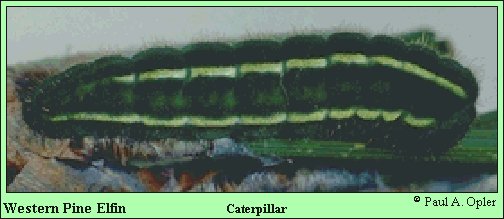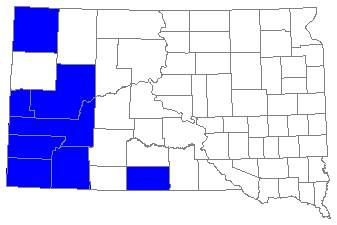 |
 

 |



Western Pine Elfin (Callophrys eryphon [Boisduval])
Wing span: 1 - 1 3/8 inches (2.5 - 3.5 cm).
Identification: Tailless. Wings reddish-brown; undersides of fore- and hindwing have very jagged dark submarginal bands.
Life history: Males perch on shrubs and small trees to look for females. Eggs are laid at the base of young needles; caterpillars feed on young needles and catkins. Chrysalids hibernate and adults emerge in spring.
Flight: One flight from May-June.
Caterpillar hosts: Young needles of hard pines including lodgepole pine (Pinus contorta), limber pine (P. flexilis), and ponderosa pine (P. ponderosa); possibly black spruce.
Adult food: Flower nectar.
Habitat: Pine forests.
Range: British Columbia east to Maine; south to southern California, Arizona, and New Mexico.
Conservation: Not usually required.
The Nature Conservancy Global Rank: G5 - Demonstrably secure globally, though it may be quite rare in parts of its range, especially at the periphery.
Management needs: None reported.
References:
Opler, P. A. and V. Malikul. 1992. A field guide to eastern butterflies. Peterson
field guide #4. Houghton-Mifflin Co., Boston. 396 pages, 48 color plates.
Scott, J. A. 1986. The butterflies of North America. Stanford University Press,
Stanford, Calif. 583 pages, 64 color plates.
Tilden, J. W. 1986. A field guide to western butterflies. Houghton-Mifflin Co.,
Boston, Mass. 370 pages, 23 color plates.
Author: Jane M. Struttmann
State and Regional References:
Opler, Paul A. 1999. Peterson Field Guide to Western Butterflies, revised
edition. Houghton Mifflin Co., Boston, Mass.
Stanford, R.E. and P.A. Opler. 1993. Atlas of Western USA Butterflies.
Privately published, Denver, Colo.
Tilden, J.W. and A.C. Smith. 1986. A Field Guide to Western Butterflies.
Houghton Mifflin Co., Boston, Mass.

